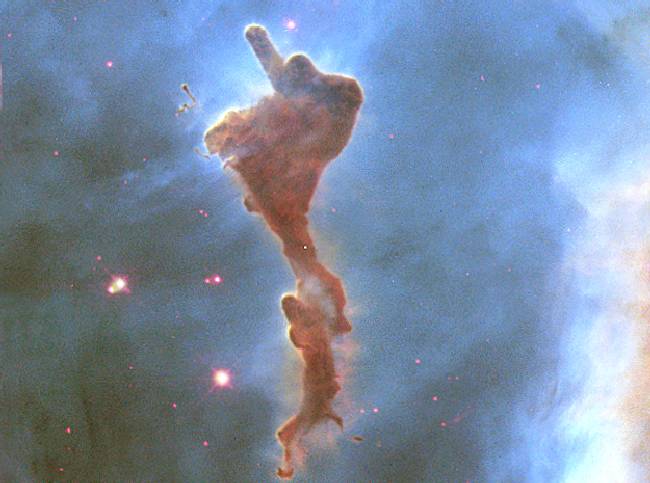Credit & Copyright: Hubble
Heritage Team
(STScI/AURA),
N. Walborn
(STScI) &
R. Barb'
(La Plata Obs.),
NASA
Explanation:
This dense cloud of gas and dust is being deleted.
Likely, within a few million years,
the intense light from bright stars will have boiled it
away completely.
Stars not yet formed in the
molecular cloud's interior
will then stop growing.
The cloud has broken off of part of the greater
Carina Nebula,
a star forming region about 8000
light years away.
Newly formed stars are visible nearby, their images reddened by
blue light being preferentially scattered by the pervasive
dust.
This unusually-colored image spans about two
light years and was taken by the orbiting
Hubble Space Telescope in 1999.
This Carina
sub-cloud is particularly striking partly because it's clear
definition stimulates the human imagination
(e.g. it could be perceived as a superhero flying
through a cloud, arm up, with a saved person in tow
below).
1999 2000 2001 2002 2003 2004 2005 2006 2007 2008 2009 2010 2011 2012 2013 2014 2015 2016 2017 2018 2019 2020 2021 2022 2023 2024 2025 |
Yanvar' Fevral' Mart Aprel' Mai Iyun' Iyul' Avgust Sentyabr' Oktyabr' Noyabr' Dekabr' |
NASA Web Site Statements, Warnings, and Disclaimers
NASA Official: Jay Norris. Specific rights apply.
A service of: LHEA at NASA / GSFC
& Michigan Tech. U.
|
Publikacii s klyuchevymi slovami:
Kil' - molecular cloud - Molekulyarnye oblaka - tumannost' Kilya
Publikacii so slovami: Kil' - molecular cloud - Molekulyarnye oblaka - tumannost' Kilya | |
Sm. takzhe:
Vse publikacii na tu zhe temu >> | |
